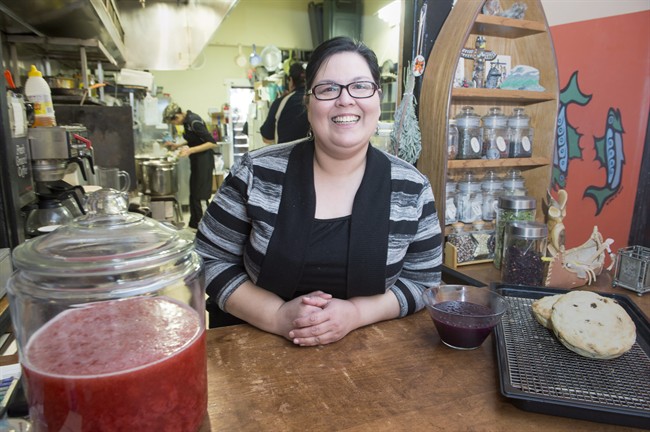Canadian cuisine might include a mix of culinary traditions, but the food of one of the country’s founding groups is largely missing. An emerging group of indigenous chefs and restaurateurs is hoping to change that.

Rich Francis, chef-owner of Seventh Fire Hospitality Group in Saskatoon, says he’s “cooking for reconciliation” as he specializes in his interpretation of modern indigenous cuisine.
“Everything that’s been taught in school is through a colonial lens. It’s not our story. It’s colonial books, so now I’m stepping into a time where we are telling our own stories through our own lens and our own vision.”
READ MORE: Regina’s Bannock House serving not just a meal staple, but also a source of income and pride
Francis, a member of the Tetlit Gwich’in and Tuscarora Nation and originally from Fort McPherson, N.W.T., was a finalist on season 4 of “Top Chef Canada” and is looking forward to opening a restaurant this summer.
Meanwhile, he’s catering and conducting events like a recent Cooking for Reconciliation dinner series in Vancouver, where he focused on local indigenous foods such as halibut, razor clams, stone fruits and sage for flavouring. He took buffalo meat with him to do a play on surf ‘n’ turf.
“I’ve been travelling raising awareness just to go beyond what people know us for, like the Indian taco and bannock and all that. That’s not truly us, who we are,” Francis said.
“It was given to us in our cultural genocide and the residential school system and all that happened to us. We’re starting to find our culinary identity now in the industry beyond bannock and all the colonial stuff that was designed to destroy us.”
Lenore Newman, a B.C. professor with a Canada Research Chair in food security and environment, says the country is seeing a resurgence in indigenous food “and a very timely one that needs to happen.”
“I think there is still serious reparation to be made though,” she adds.
READ MORE: Canada’s list of 100 best restaurants of 2017 revealed
During field work for her recent book, “Speaking in Cod Tongues: A Canadian Culinary Journey,” Newman found indigenous groups played a huge role in helping early settlers learn to survive.
“Then you enter this horrible period where indigenous cuisine was actively destroyed and used as a weapon. The biggest example is the clearing of the bison and how that was basically a genocide,” says Newman, who teaches at the University of the Fraser Valley in Abbotsford, B.C.
“Out here on the West Coast the potlatch was banned. In residential schools, people were taken away from their indigenous foods. They were prevented from using them or talking about them.
“We have a lot of reckoning to do and some of that is culinary. And so what that meant was for a very long time you didn’t hear about indigenous cuisine except very peripherally as kind of exotic.”
Newman has eaten in indigenous restaurants in Vancouver, Haida Gwaii, B.C., at a Songhees First Nations food truck in Victoria and at Tea-N-Bannock in Toronto.
Tina Ottereyes, who manages Tea-N-Bannock, agrees First Nations food is “very underrepresented” in Canada’s restaurant sphere and is happy more eateries are opening.
“We’re starting to share more of our culture and more of our food,” says Ottereyes, from Wemindji Cree First Nation on James Bay in Quebec.
“When I grew up we hunted and we trapped and we fished. That was my culture, that was the food that I ate … Each tribe has a different diet according to their area.”
READ MORE: Head of U of S fruit program wants haskap berries to flourish in Canada
The menu at Tea-N-Bannock reflects traditional dishes from different tribes. Hominy corn grown by a local farmer is the base for their Ojibwa corn soup, made through a labour-intensive process. The corn is dried after picking and the kernels removed. They’re boiled for several hours in wood ash to remove the hard outer shell, allowing the inner kernel to get “nice and cooked and plumped up,” Ottereyes said.
Wild rice comes from First Nations people in northwestern Ontario. Teas include a fruity herbal blend made by the grandmother of a staff member in Tyendinaga Mohawk Territory near Belleville, Ont.
- Life in the forest: How Stanley Park’s longest resident survived a changing landscape
- Bird flu risk to humans an ‘enormous concern,’ WHO says. Here’s what to know
- Roll Up To Win? Tim Hortons says $55K boat win email was ‘human error’
- Election interference worse than government admits, rights coalition says
Though meat like elk and bison are prepared in a traditional way, they are farmed, not wild, because the product has to be certified and inspected.
Francis believes there should be some leniency when it comes to wild food.
“The regulations that are put in place by the government don’t allow us to fully express ourselves.”
READ MORE: Food Network star begins cookbook compilation in Saskatchewan
Elsewhere in Toronto, NishDish, a cafe focused on Anishinaabe recipes, was slated to open this month in Toronto. Pow Wow Cafe, which launched last fall, features Objibwa tacos using fried bannock instead of tortillas.
A smattering of colleges also offer indigenous culinary courses.
Francis, who received his chef training at Stratford Chefs School, originally learned traditional recipes in Moose Factory on James Bay and Iqaluit in Nunavut from people who still live off the land.
“You won’t find any of this stuff in history books, or cookbooks for that matter.”

Comments